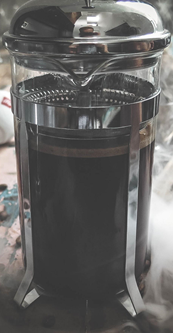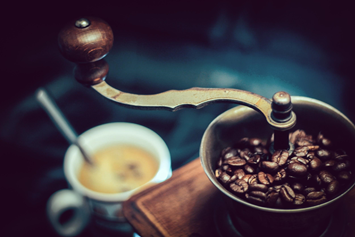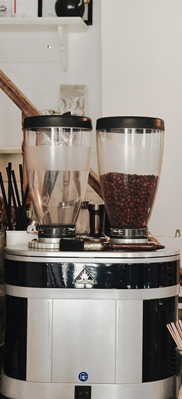Your coffee drinking experience starts with coffee grinders. So many coffee drinkers focus heavily on their coffee maker, but so little on the device that grinds their beans. A good brew starts with a well-ground bean. This is your guide to everything you need to know about the device that starts your coffee making routine.
Grinding Coffee Beans

A good garden starts with high quality soil. Building a good house starts with strong foundations. A beautiful painting starts with a careful selection of a canvas.
It is the same with brewing a cup of coffee and starting out with a good bean. While choosing the bean is important, so too is the importance of how you grind that bean.
Importance of Fresh Grounds
Fresh-ground coffee makes the best coffee. Using pre-ground coffee that sits in the fridge for days at a time means using stale, dehydrated coffee grounds. We all know that life is too short for inferior coffee grounds. If you’re after a cup of coffee that will rival your corner shop, freshly ground beans will mean more to your homemade cup of coffee than a top-of-the-line espresso machine.
Size of the Grind

When it comes to making coffee, the size of the ground particles of coffee beans is crucial to transferring flavour and caffeine from the bean to the water. Particle size is also dependent on what type of coffee maker you choose to make coffee. The finer the coffee grind size, the less time it needs to be in contact with the water. For this reason, espresso will need to be ground more finely than what is needed for a French press.
“It’s all in the grind, Sizemore. Can’t be too fine, can’t be too coarse. This, my friend, is a science.”
Ewan McGregor playing Specialist Grimes in Black Hawk Down
Before you choose the size of your grind, consider which coffee maker you are using to make coffee:
- Turkish – Super Fine ground
- Espresso – Super Fine ground
- Drip Percolator – Fine ground
- Pour Over – Coarse-Fine ground
- Aeropress – Medium-Fine ground
- French Press – Coarse ground
- Cold Brew – Coarse ground
If you want to make coffee using a variety of methods, make sure that you choose a grinder that will allow you the freedom of changing the size of the grind.
When Choosing a Grinder
There are multiple factors to take into account when choosing your coffee grinder. As well as the size of what you are grinding, you should also consider practicality and what effect your grinder may be having on the bean.
Burr and Blade Grinders

The two main types of coffee grinders are burr grinders and blade grinders.
A blade grinder has a propeller that chops the coffee beans very quickly. Many coffee lovers dislike this type of grinder because of the effect that it has on the bean, usually creating a particle that is too fine for most purposes.
When using a blade grinder you have less control over what particle size you get, meaning a risk that the ground will be either too fine or too coarse. You can also wind up with coffee grounds that are inconsistent.
A burr grinder on the other hand usually works with two wheels that have texture to them. It crushes the bean into smaller pieces until they get to the point that they can fall between the two wheels.
Think of a burr grinder similar to how a pepper grinder works. There is more consistency in the size of the particle for your brew since you can adjust the space between the two grinding disks. Most hand coffee grinders (or hand grinders) are burr grinders.
Dosing and Non-Dosing

Some coffee grinders, especially commercial ones, will have a setting to only grind a certain amount of coffee for your needs. It may even hold a portafilter for an espresso machine. Consider whether or not your espresso machine will be your main device for making coffee before choosing a dosing option like this. It may also be that you aren’t reaching for repeatability and would prefer to make your cup of coffee slightly unique each time!
Heat
Whether the coffee grinder heats the coffee is a consideration when making your selection. The best coffee grinder will not heat the bean too much, since this can alter the taste of the end brew often delivering a burnt flavour.
Speed of Grinder

Many blade grinders are high-speed grinders. High-speed grinders risk heating the bean too much, as well as generating a static charge. High-speed blade grinders do not offer a lot of control over grind size.
Low-speed burr grinders are often considered the best coffee grinder to choose in the minds of many coffee lovers. The bean does not heat too much, there is no static charge generated in the grounds, they run quietly, and generally offer the coffee maker more control over the grind.
Noise
An electric coffee grinder is often a very noisy operation. Most burr grinders tend to be quieter regardless of whether they are hand or electric grinders. Loud kitchen appliances are usually frustrating to have in the house and may risk waking others when you’re trying to have a quiet cup of solitude at six in the morning.
Cleaning

Choose a coffee grinder that is easy to clean and isn’t at risk of getting too bogged up with coffee beans. If it is an instrument that requires constant and difficult maintenance, then it becomes an appliance that you are more at risk of avoiding the use of. Many manual burr grinders come with only a few parts that are easy to take apart and put together again.
Conclusion – Respect the Bean
You’re trying to make a great cup of coffee in the comfort of your home, office, or even while camping or travelling the country. Before picking your coffee making device to start your coffee-making ritual, make sure you reach for the right instrument to grind your bean. It will make all the difference between a good and a bad cup of coffee.
